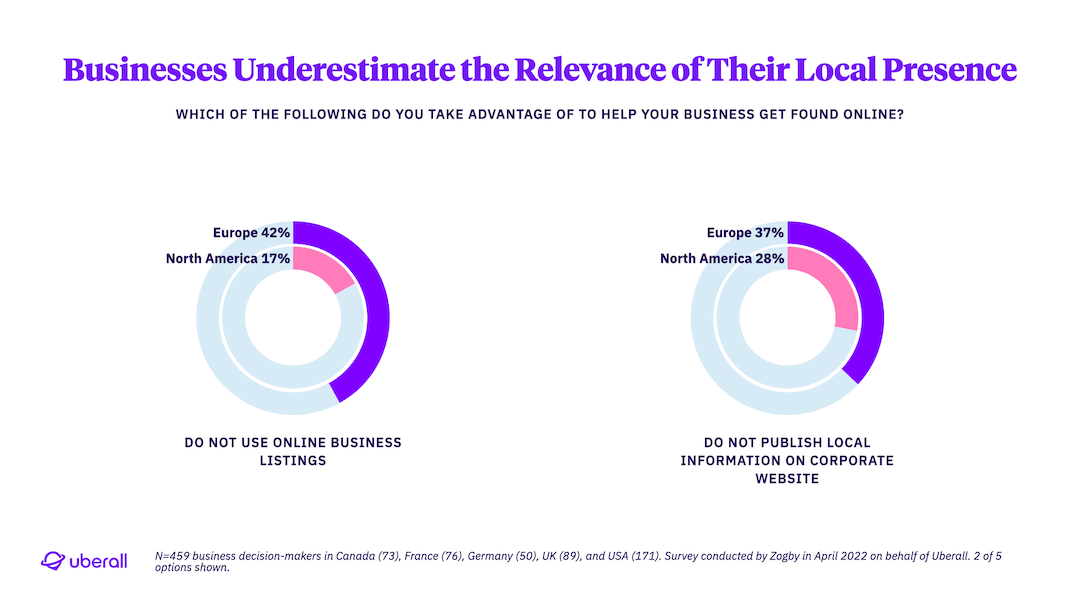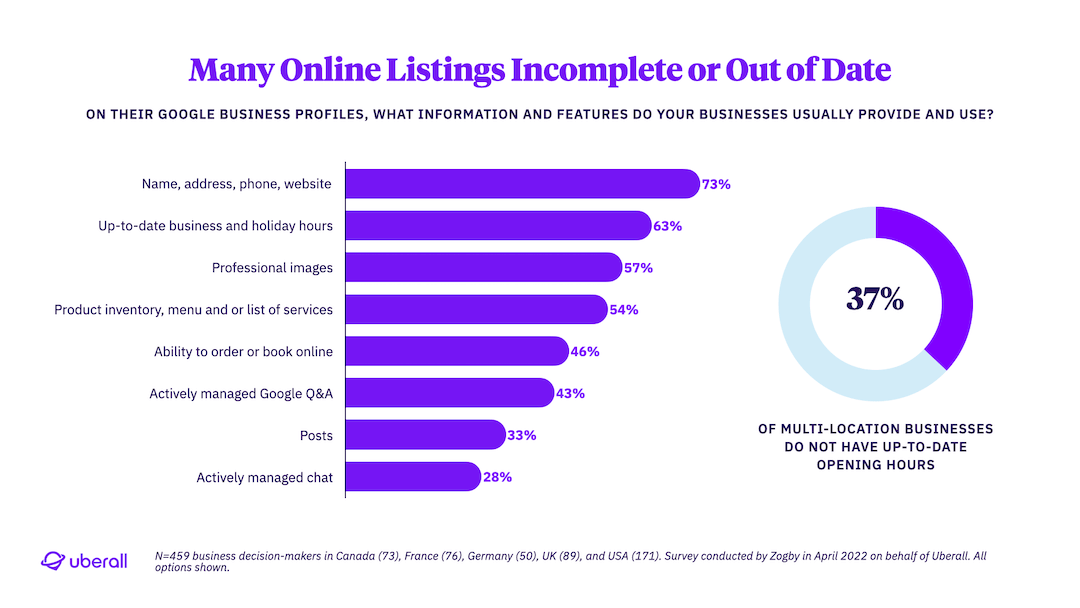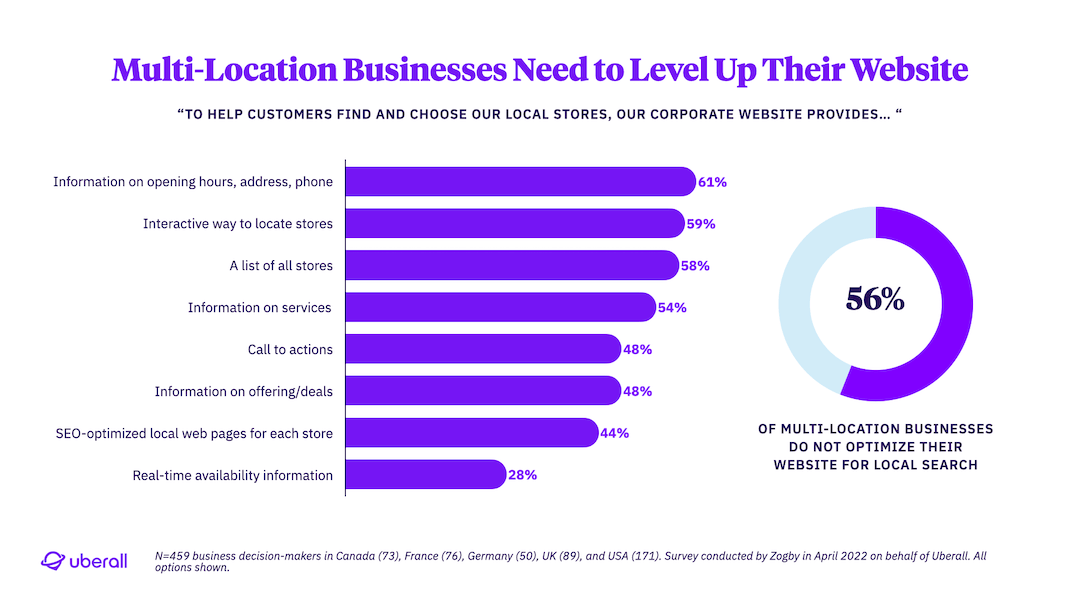
Get Found: How to Improve Online Visibility and Give Revenue a Boost
Benchmark for Local Digital Marketing Maturity—Data Deep Dive
- 36% of multi-location businesses still manually manage local profiles
- 29% of multi-location businesses do not use online listings
- 56% of multi-location businesses do not optimize their website for local search
n=459 business decision-makers in Canada (73), France (76), Germany (50), UK (89), and U.S. (179). Survey conducted by Zogby Analytics in April 2022 on behalf of Uberall.
Get Found by More High-Intent Online Buyers
It’s no secret that the majority of consumers search online for local businesses. A trend that was already well-established before the pandemic has only intensified as consumers increasingly blend their online and offline buying experiences. Nearly 70% of them say at least half of their search activity has a local (hence offline) intent—a clear indicator that hybrid journeys have become the new standard.
Therefore, the first step any business can take to be found is to establish a visible and accurate online presence. But to what extent are companies fully optimized to ensure their nearest location is visible with high-intent online buyers?
For our maturity research, we surveyed 459 businesses to understand their ability to get found by customers today. Here are the key insights:
Insight #1: Businesses Underestimate the Relevance of Their Local Presence
Publishing local information on online directories has been foundational to local marketing for years, and we were surprised to see that almost every third business (29%) said they don’t use online listings to present their locations. The lack of listings is even more dramatic in Europe (42%) than in North America (17%), expressing a strong need for European businesses to level up their visibility efforts and use this core practice.

Another big room to increase online visibility is to present business locations on a corporate website—every third business (32%) in our survey said they don’t use that opportunity. Here, again, the share of European businesses missing out is higher (37%) than that of North American businesses (28%).
Key Takeaway: Corporate-level digital marketing is not enough.
According to Think With Google, shoppers go online first in over 60% of occasions. One of the most important and effective ways businesses have of being found online is curating and updating an online business listing—such as a Google Business Profile (formerly known as a Google My Business) that is localized for a store or branch.
Insight #2: Many Online Listings Are Incomplete or Out of Date
Of the businesses surveyed, more than a quarter do not get the basics right. Only 73% are providing fundamental data like name, address, phone, and website information (NAP) in their profiles. Similarly only 63% say they include opening hours in their Google profile.

Key Takeaway: Accurate and complete listings are a top Google 3-Pack ranking factor.
To let Google know if your business, for example, serves hamburgers, has an accessible entrance, or is open now, your business must have accurate data. Something as simple as up-to-date opening hours is important since searches for “open now near me” grew globally by over 400% YOY in 2021.
“Optimizing your Google Business Profile and reviews now account for over half of your local map pack ranking,” says Krystal Taing, Senior Solutions Manager at Uberall.
Insight #3: Multi-Location Businesses Need to Level-Up Their Website
Only about six in ten businesses are using their website to provide addresses and opening hours (61%), a list of stores (58%), or an interactive map (59%). Far fewer (48%) are offering calls to action (such as appointment scheduling or click-to-call) that make it possible for customers to continue their buying journey.

Similarly, only 44% say they provide SEO-optimized local web pages for each store. Having such pages is essential in establishing a strong search presence for each location—and is a low-hanging fruit that too few businesses are leveraging in their strategies to get found.
Key Takeaway: Improve Your Website for Local Visibility
Having a website is one of the first steps businesses usually take to boost visibility—but when it comes to helping local businesses be found, those sites are often not taking the steps they need to show up in search results and win walk-in traffic.
Insight #4: Local Presence Performance Tracking Greatly Lacking
It is not enough to simply post web pages or listings. Companies must optimize and ensure that those resources are performing, getting attention, and driving sales. Yet, only half (49%) of businesses told us they are even tracking website traffic—much less looking at user behavior (40%), tracking local pages for optimization (38%), or looking at how their websites are converting into sales (30%).
Only about one in three (36%) businesses surveyed currently looks at the performance of their listings and how they rank in local search results.

Key Takeaway: What Gets Measured, Gets Managed
With only a few businesses measuring their local marketing performance, honing your insights can be a real game changer. Assessing and analyzing your performance is the best way to improve it and gain a competitive edge.
Insight #5: Businesses Rely Heavily on Antiquated, Manual Processes
When it comes to online visibility, having local listings is just one part of the success story. The other part is about the process behind listings management— who manages them and how? Our survey showed that 49% of companies are still managing listings exclusively from the corporate office—without asking store managers for help in keeping them up to date. This can prove problematic, as local managers are typically the closest to the most accurate information about things like store hours, services, or events.
Similarly, only 63% of businesses surveyed say they are leveraging listings management tools to help them manage their profiles and business information across directories and listings sites, including Google Business Profiles. This is an oversight that likely sees the other 36% of companies mired in time-consuming manual processes—risking inconsistencies or duplications in their data and hence torpedoing their chances to rank in local searches.

Assess Your Own Local Marketing Maturity
Do you know whether your business can easily get found by customers and move them along the journey?
Assess your local marketing maturity and benchmark against your competitors.
Ready to Transform Your Business?
Connect with our partnership team to learn how Uberall can help you achieve similar results. Get a personalized consultation and discover the opportunities waiting for your business.
Resources









